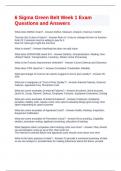6 Sigma Green Belt Week 1 Exam
Questions and Answers
What does DMAIC mean? - Answer-Define, Measure, Analyze, Improve, Control
That are the 3 rules of Value? - Answer-Rule #1: It has to change the form or function
Rule #2: Customer must be willing to pay for it
Rule #3: Must get it right the first time
What is waste? - Answer-Anything that does not add value
What does DOWNTIME stand for? - Answer-Defects, Overproduction, Waiting, Non-
Utilized Talent, Transportation, Inventory, Motion, Extra Processing
What is the Process Improvement Umbrella? - Answer-Covers Defects and Slowness
What does CPR stand for? - Answer-Consistent, Predictable, Reliable
What percentage of revenue do experts suggest is lost to poor quality? - Answer-25-
30%
What are 4 categories of "Cost of Poor Quality"? - Answer-Internal Failures, External
Failures, Appraisal Cost, Prevention Cost
What are some examples of Internal Failures? - Answer-Accidents, Work-arounds,
Quick fix, Scrap, Rework, Defects, Employee Turnover, Equipment Downtime, Sorting
What are some examples of External Failures? - Answer-Customer complaints,
penalties, liability suits, repaire costs, time spent evaluating things gone wrong, time
spent responding to upset customer
What are some examples of Appraisal Costs? - Answer-Audits, Resting, Inspection,
Equipment Calibration
What are some examples of Prevention Costs? - Answer-Error proofing, Capability
studies, procedure writing, applicant screening, education & training
What happens when companies start tracking costs over time? - Answer-They should
see preventative costs go up at first, then level out.
The internal & external failure and appraisal costs should come down over time
What is the basic purpose of stats? - Answer-To provide a numerical summary of data
so we can analyse it, provide basis for making inferences about the future, provide
, foundation for assigning processes' capability, and provide common language that we
can use throughout organization to describe processes.
What are the two types of data? - Answer-Attribute data & Variable data
What is Attribute data? - Answer-Qualitative in nature, only 2 possible outcomes (Y/N,
Pass/Fail), can be characterized in classifications, aka "Discrete Data"
What is another name for Attribute data? - Answer-Discrete Data
What is Variable data? - Answer-Quantitative in Nature, what we measure,
"Continuous" because we measure over a continuum.
How to tell difference between 2 data types: - Answer-Variable/Continuous - if dividing if
half makes sense. Ie. Time, pressure, speed, feed rate
Attribute - if dividing in half doesn't make sense. Ie can't have 8.5 people at an event
Descriptive Stats - Answer-Describes what data looks like
Measure of location - Answer-Measures mean, median, or mode (central attendances)
Measure of Variation - Answer-Aka Dispersion. Ue the range, interquartile range, STD,
or variance to understand dispersion of data
When should you use Range, and when to use Standard Deviation? - Answer-Range - if
dataset is skewed
Standard Deviation/Var - when bellshaped
Standard deviation - Answer-Unit of measure for distances from the mean.
Hypothesis testing - Answer-Ued when we are making inferences about what data is
telling us
Statistical difference - Answer-A difference/change to the process that notably, w/ some
defined degree of confident, didn't happen by chance
Practical difference - Answer-State may tell you a real change happened, but you must
connect/convert that back to the biz logic of it all
What is a tollgate? - Answer-Between each phase or step many companies employ a
"tollgate" to control the process. Only when the person leading the project confirms that
the team has successfully completed the previous phase may they pass the tollgate and
move to the next phase. Tollgates are usually reviewed by a higher authority, such as
the Master Black Belt for a Black Belt, or a Business Quality Council.




